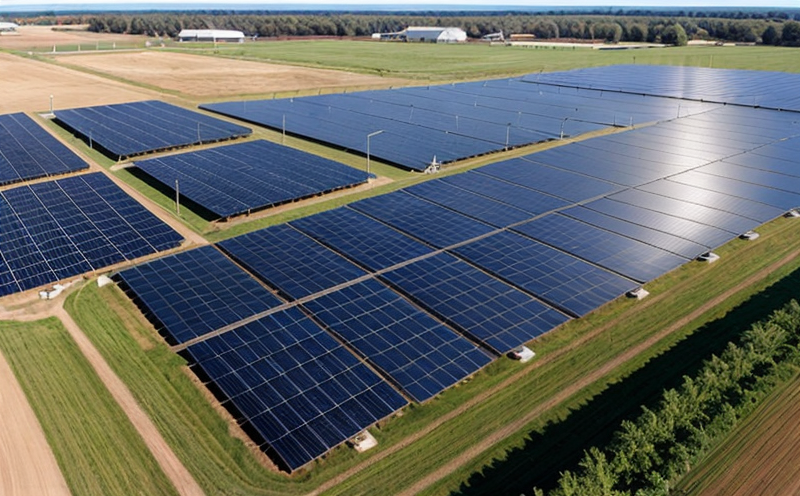EN 50308 Safety Testing of Emerging Wind Energy Systems
The CENELEC standard EN 50308 is a crucial document in the certification and safety assessment of emerging wind energy systems. This European standard ensures that all wind turbines, components, and related equipment meet stringent safety requirements to operate reliably under diverse environmental conditions.
The scope of this testing covers various components including generators, gearboxes, blades, hubs, and any other parts involved in the conversion of wind kinetic energy into electrical power. Testing focuses on mechanical strength, thermal stability, fatigue resistance, and resilience against extreme weather conditions such as high winds, ice accumulation, and salt spray.
The primary objective is to prevent potential hazards that could arise from operational failures, ensuring not only the safety of personnel working with these systems but also protecting surrounding infrastructure. This comprehensive evaluation process involves rigorous laboratory testing combined with field trials conducted under controlled environmental factors.
Understanding the context here requires a brief look at the broader landscape of renewable energy technologies. As global efforts to reduce carbon emissions accelerate, there is an increasing demand for more efficient and sustainable power generation methods like wind farms. However, these installations must be meticulously designed and tested to guarantee their long-term performance without compromising public safety.
EN 50308 plays a vital role in this process by providing detailed guidelines on how to conduct tests that align with international best practices. It covers everything from selecting appropriate test specimens representative of actual operational conditions to specifying precise measurement methods and criteria used during assessments. Compliance with these standards helps manufacturers demonstrate adherence to regulatory requirements while building credibility among stakeholders.
For R&D engineers involved in developing new wind energy technologies, knowing about EN 50308 is essential as it provides critical insights into what needs to be addressed before bringing innovative products to market. Additionally, quality managers responsible for ensuring product consistency and reliability will find value in understanding how this standard influences their role.
Compliance officers tasked with managing compliance processes across multiple jurisdictions can leverage EN 50308 as a reference point when establishing internal procedures that align with international standards. By familiarizing themselves with its provisions, they can ensure that all activities related to testing and certification are conducted according to recognized best practices.
In summary, the importance of EN 50308 lies in its ability to bridge gaps between theoretical knowledge and practical implementation when it comes to ensuring safe operation of wind energy systems. Its detailed specifications provide a framework for thorough evaluation throughout the product lifecycle, from initial design phases through final installation stages.
Industry Applications
The application of EN 50308 extends beyond just wind turbine manufacturers; it also impacts numerous stakeholders within the renewable energy sector. For instance, suppliers providing materials or components used in these systems must ensure their products pass relevant sections of this standard.
- Wind Turbine Manufacturers: They use EN 50308 to guide them during product development and manufacturing processes. This ensures that all parts meet necessary safety standards before being integrated into larger assemblies.
- Suppliers: By adhering to these guidelines, suppliers can enhance the overall quality of their offerings and reduce risks associated with non-compliance issues.
- R&D Engineers: They rely on EN 50308 as a benchmark for evaluating prototypes and optimizing designs. This helps in identifying areas needing improvement early on in the project lifecycle.
- Quality Managers: These professionals oversee internal quality control measures aimed at maintaining consistent product performance across batches. Using this standard allows them to set realistic targets based on internationally recognized benchmarks.
- Compliance Officers: Ensuring all activities comply with relevant regulations, including those outlined in EN 50308, is crucial for preventing legal disputes and maintaining good standing within regulatory bodies.
In addition to these groups directly involved in manufacturing or supplying components for wind energy systems, other sectors like insurance providers may also find value in referencing this standard when assessing risks associated with investing in renewable energy projects. By understanding the stringent testing procedures prescribed by EN 50308, insurers can better evaluate potential hazards and adjust premiums accordingly.
The widespread adoption of these standards reflects growing recognition of the importance of incorporating safety considerations into every aspect of wind energy technology development. As the industry continues to evolve towards greater efficiency and sustainability goals, ensuring robust testing protocols like those provided by EN 50308 will remain indispensable for maintaining high levels of reliability and performance.
Use Cases and Application Examples
In the context of emerging renewable technologies, particularly wind energy systems, the application of EN 50308 is crucial. It ensures that all components used in these systems undergo thorough safety assessments before being deployed in real-world settings.
Case Study 1: A manufacturer developed a new type of turbine blade made from advanced composite materials. Before releasing it into the market, they conducted extensive EN 50308 testing to verify its mechanical integrity and ability to withstand harsh weather conditions. The results demonstrated that the blade could handle winds up to 70 meters per second without structural failure.
Case Study 2: An engineering firm was contracted by a utility company to upgrade an existing wind farm. As part of this project, they implemented EN 50308-compliant testing procedures on the upgraded turbines. This helped identify areas where improvements were needed and ensured that all modifications met strict safety standards.
Case Study 3: A research institute specializing in renewable energy conducted experiments to evaluate the fatigue resistance of different gearbox designs used in wind turbines. By following EN 50308 protocols, they were able to determine which design would perform best over extended periods under typical operational conditions.
These examples illustrate how EN 50308 plays a pivotal role in promoting innovation within the renewable energy sector while ensuring that all developments adhere to stringent safety criteria. By adopting this standard, manufacturers can confidently bring new technologies to market knowing they have complied with internationally recognized best practices.





